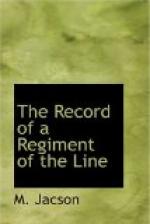Orders were received by this half battalion at 9 a.m. on November 2nd to retire on to Ladysmith. The defenders of Ladysmith being unaware of the fact that any of their own troops were in front of them, and mistaking friend for foe, got down on their knees to fire as the companies of the Devons appeared in sight.
The half battalion which had retired with the rest of the force into Ladysmith on October 30th received orders at 10 a.m. on the 31st to strike camp, move off and form part of the garrison of section “A” of the defences of Ladysmith, under the command of Colonel W.G. Knox, C.B. The second half battalion followed them.
CHAPTER II
SIEGE OF LADYSMITH
1899-1900
The siege of Ladysmith had now commenced; communication to the south was interrupted on November 2nd, and on the same day the Boers had their guns in action on Bulwana Mountain and were shelling the works and town freely.
The perimeter of Ladysmith was divided into four sections, A, B, C, D, under Colonel W.G. Knox, General Howard, Colonel Hamilton, and Colonel Royston respectively. Section A extended from Devon Post to Cove Redoubt; on the west of this was section B, extending as far as Range Post on the Klip River. Section C included Maiden Castle, Wagon Hill, and Caesar’s Camp, whilst the plain between Caesar’s Camp and Devon Post was held by the Natal Volunteers under Colonel Royston.
The battalion was ordered to take up the two posts of Cemetery Hill and Helpmakaar Hill. These were the most eastern kopjes of the defences. They skirted the Helpmakaar road and were immediately under Bulwana and Gun Hill. These were distant only some five thousand yards, and dominated Devon Post.
The battalion was distributed: three companies on Helpmakaar Hill, two companies on Cemetery Hill, with three companies in reserve near the road and river-bed immediately beneath Cemetery Hill.
Devon Post received its first shells on the morning of the 3rd. These were aimed at the tents of the reserve companies, which were rather ostentatiously pitched on the plain by the river-bed under Cemetery Hill. The shells were fired from a high-velocity 3-inch gun on Bulwana. The tents were immediately moved closer under the hill, where they were out of sight from Bulwana. The Boer guns were then trained on to the working parties, and some fifty shells were burst in the works (just commenced and affording little cover) on Helpmakaar and Cemetery Hill posts, but without doing much damage. After this, owing to shell fire, it was impossible to work except at night, or when Bulwana was obscured by fog. The fortifications and defences were, however, hastily pushed forward, and the platforms for the two large and ancient howitzers known as “Castor” and “Pollux” were soon completed.
Shortly after the commencement of the siege one of the few shells fired into Ladysmith which did any damage, burst amongst a party of Natal Carbineers on the road under Cemetery Hill, killing five men and seven horses.




